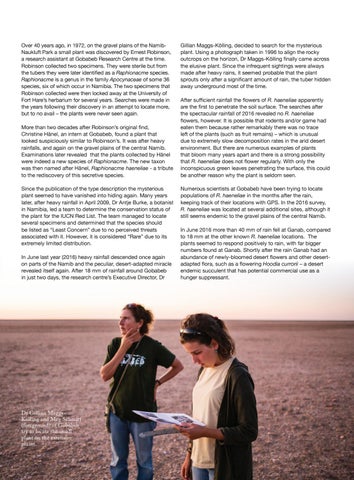Over 40 years ago, in 1972, on the gravel plains of the NamibNaukluft Park a small plant was discovered by Ernest Robinson, a research assistant at Gobabeb Research Centre at the time. Robinson collected two specimens. They were sterile but from the tubers they were later identified as a Raphionacme species. Raphionacme is a genus in the family Apocynaceae of some 36 species, six of which occur in Namibia. The two specimens that Robinson collected were then locked away at the University of Fort Hare’s herbarium for several years. Searches were made in the years following their discovery in an attempt to locate more, but to no avail – the plants were never seen again. More than two decades after Robinson’s original find, Christine Hänel, an intern at Gobabeb, found a plant that looked suspiciously similar to Robinson’s. It was after heavy rainfalls, and again on the gravel plains of the central Namib. Examinations later revealed that the plants collected by Hänel were indeed a new species of Raphionacme. The new taxon was then named after Hänel, Raphionacme haeneliae - a tribute to the rediscovery of this secretive species. Since the publication of the type description the mysterious plant seemed to have vanished into hiding again. Many years later, after heavy rainfall in April 2009, Dr Antje Burke, a botanist in Namibia, led a team to determine the conservation status of the plant for the IUCN Red List. The team managed to locate several specimens and determined that the species should be listed as “Least Concern” due to no perceived threats associated with it. However, it is considered “Rare” due to its extremely limited distribution. In June last year (2016) heavy rainfall descended once again on parts of the Namib and the peculiar, desert-adapted miracle revealed itself again. After 18 mm of rainfall around Gobabeb in just two days, the research centre’s Executive Director, Dr
Dr Gillian MaggsKölling and Meg Schmitt (foreground) of Gobabeb try to locate the small plant on the extensive plains.
Gillian Maggs-Kölling, decided to search for the mysterious plant. Using a photograph taken in 1996 to align the rocky outcrops on the horizon, Dr Maggs-Kölling finally came across the elusive plant. Since the infrequent sightings were always made after heavy rains, it seemed probable that the plant sprouts only after a significant amount of rain, the tuber hidden away underground most of the time. After sufficient rainfall the flowers of R. haeneliae apparently are the first to penetrate the soil surface. The searches after the spectacular rainfall of 2016 revealed no R. haeneliae flowers, however. It is possible that rodents and/or game had eaten them because rather remarkably there was no trace left of the plants (such as fruit remains) – which is unusual due to extremely slow decomposition rates in the arid desert environment. But there are numerous examples of plants that bloom many years apart and there is a strong possibility that R. haeneliae does not flower regularly. With only the inconspicuous green leaves penetrating the surface, this could be another reason why the plant is seldom seen. Numerous scientists at Gobabeb have been trying to locate populations of R. haeneliae in the months after the rain, keeping track of their locations with GPS. In the 2016 survey, R. haeneliae was located at several additional sites, although it still seems endemic to the gravel plains of the central Namib. In June 2016 more than 40 mm of rain fell at Ganab, compared to 18 mm at the other known R. haeneliae locations. The plants seemed to respond positively to rain, with far bigger numbers found at Ganab. Shortly after the rain Ganab had an abundance of newly-bloomed desert flowers and other desertadapted flora, such as a flowering Hoodia currorii – a desert endemic succulent that has potential commercial use as a hunger suppressant.
